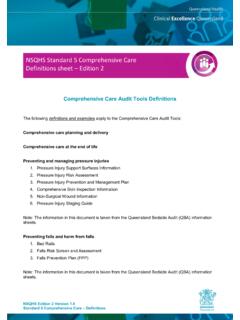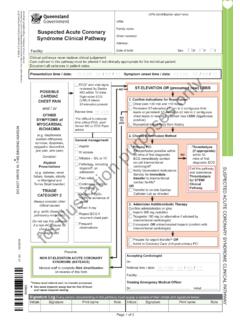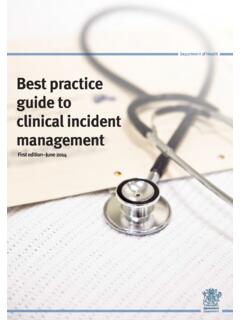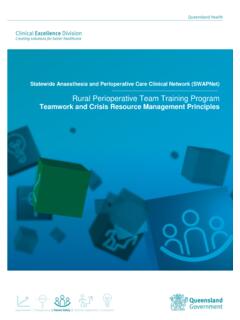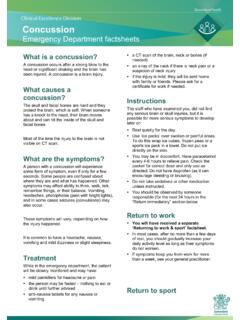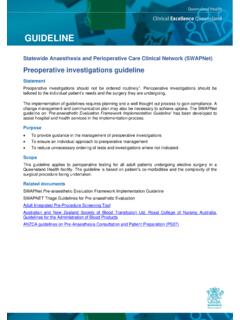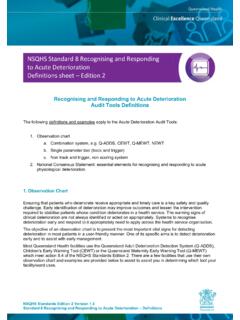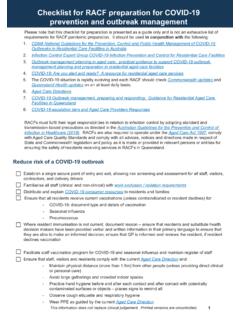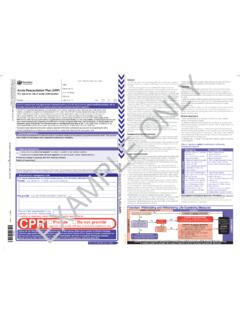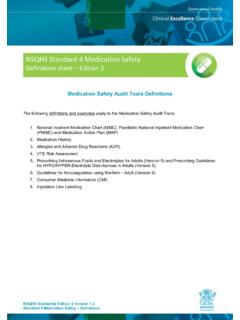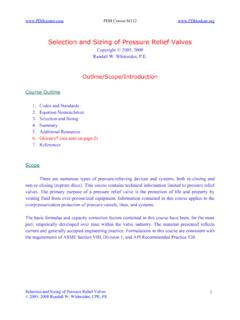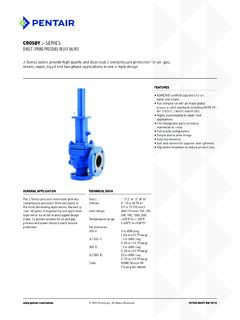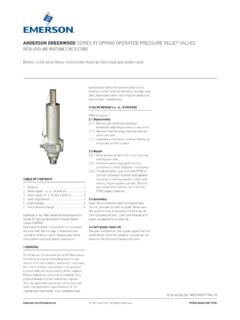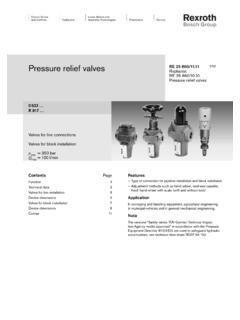Transcription of NSQHS Standard 8 Pressure Injury
1 Pressure Injury Audit Tools Definitions The following definitions and examples apply to the Pressure Injury Audit Tools: 1. Pressure Injury Equipment 2. Pressure Injury Risk Assessment 3. Pressure Injury Prevention and Management Plan 4. Pressure Injury Staging Guide and Anatomical Sites 5. Non-Surgical Wounds Types 6. Consent for Skin Inspection Note: The information in this document is taken from the Queensland Bedside Audit (QBA) information sheets. 1. Pressure Injury Equipment As outlined in the Queensland Health Best Practice Guidelines for Pressure Injury Prevention and Management, using Pressure redistribution devices does not eliminate Pressure Injury risk. Pressure Injury prevention requires thorough clinical care, regular repositioning, ongoing assessment and the appropriate support surface.
2 A variety of support surfaces exist which provide varying degrees of Pressure relief . Local procedures must be followed for selection and use within your facility. Mattress Pressure Reducing Standard Foam (Reactive) Pressure redistribution mattresses are used for therapeutic Pressure reduction and patient comfort. For Queensland Health facilities, the minimum requirement is that a Pressure reducing mattress should be available on all beds. A variety of Standard foam mattresses are available and vary in size, density, thickness, and weight capacities. ( Cirrus1A, Maxifloat, Pentaflex, SoftForm, Soft Touch, SXS198 Simuflex) Note: Vinyl mattresses should not be in use. Mattresses covered with a vinyl cover are not considered a static* device as the vinyl does not conform to the Pressure load applied.
3 NSQHS Standard 8 Pressure Injury Definitions sheet NSQHS Standard 8 Pressure Injury Definitions sheet - 2 - 17/07/2014 Mattress Alternating Replacement (Active) Active/Dynamic*: air mattresses that replace a Standard hospital mattress and are alternating ( Alternating Alpha Response 4, Auto logic 200, Bi-wave Carer, Cairwave, ClinActiv, Nimbus, Nodec 3, Proficare) ( Low air loss - Breeze) Mattress Special / self adjusting (Reactive) High specification mattresses for Pressure reduction (can be specialty foam or air mattresses) that are NOT alternating or low air loss ( Accumax, AtmosAir, Mighty Max, Prime Air) This category is to be selected for those mattresses that are not considered a Standard foam mattress, or an alternating or low air loss.
4 Overlays Pressure Reducing Overlay Non-powered (Reactive) Mattress overlays that are being used in conjunction with Standard hospital mattress and are NOT alternating or low air loss ( Spencos; polyester fibre overlays) Note: Fibre-filled overlays may provide some comfort or protection from friction, however must not be used on top of Pressure redistribution devices as they will limit the device s Pressure redistribution properties. Overlays Pressure Reducing Overlay Powered (Reactive) Constant low Pressure mattress overlay. Air filled cells powered. Need to be used in conjunction with Standard hospital mattress (eg. Hill-Rom) Overlays Alternating Mattress (Active) Alternating mattress overlays that are being used in conjunction with Standard hospital mattress (eg: Autologic 110, AlphaXcell, Alpha Response 3) Specialty bed system An integrated bed and mattress system which incorporates a bed frame and a dynamic mattress or surface which is alternating, low air loss, constant low Pressure , or air-fluidised for the purpose of relieving/reducing Pressure .
5 They may offer kinetic movement, bariatric capabilities, various positioning options, and imaging compatible surfaces. Bed and mattress can not be used exclusively of each other. ( Total Care Bed, Therapulse, Clinitron) NSQHS Standard 8 Pressure Injury Definitions sheet - 3 - 17/07/2014 Pressure Reducing Chair Pressure reducing chairs at the bedside are more than the Standard bedside chair. They do not require a foam cushion to be put on top of the seat surface because an integrated cushion with specialty foam is built into the chair, as well as a specialty cover. These chairs are an improvement to foam cushions sitting on the Standard bedside chair. Note: Two-way stretch vapour permeable fabric over high density foam.
6 Cushions Reactive (Static): Cushions that are being used in place of or addition to a basic chair/wheelchair base/cushion and are NOT alternating or low air loss ( specialty foam/gel/air-filled; products Jay, MacMed, Roho) Active (Dynamic): Cushions that are being used in place of or addition to a basic chair/ wheelchair base/ cushion and are alternating or low air loss ( Aura) Positioning Devices Adjunct Devices: Used for positioning or to reduce shear and to provide Pressure relief ( foam wedges, pillows, bed cradle) Comfort Devices: Provide comfort only and are not Pressure redistribution aids ( sheepskins) Other: Select Other for any other equipment item used to facilitate comfort, positioning or to reduce shear and friction not listed above.
7 ( eggshell foam, booties, slide sheets, limb elevation devices, head cushions (foam/gel), convoluted (egg crate) devices, widgets) NOTE: avoid Blueys/Kylies as they can reduce immersion qualities of Pressure redistribution mattresses. Do not use doughnut type devices, water filled gloves/casks as Pressure redistribution aids. NSQHS Standard 8 Pressure Injury Definitions sheet - 4 - 17/07/2014 For Queensland Health staff, please go to QHEPS for further information on special populations. Regular repositioning aids Pressure redistribution. Staff must assist patients at risk or unable to move independently and/or redistribute Pressure with regular repositioning. Be careful to eliminate any shearing or friction forces.
8 Refer to Section of the statewide best practice guidelines. Generally, the term Pressure redistribution devices encompasses: o Reactive: Pressure Reducing: Reduces tissue interface Pressure but does not consistently maintain interface Pressure below capillary Pressure Standard hospital foam mattress. o Active: Pressure Relieving: Consistently maintains tissue interface Pressure below capillary closing Pressure (25mmHg) Nimbus Reactive (Static) devices are designed to increase conformability to body contours and reduce surface tension or provide constant low Pressure . These devices are used to optimise Pressure reduction and relief and reducing shear and friction. Active (Dynamic) devices are attached to a power source to enable their function.
9 They are used for Pressure redistribution, envelopment and immersion, reduction of friction and shear forces, relieving Pressure in cycles for individuals considered moderate to high risk . They are good to use when a Pressure Injury exists and the person cannot be positioned off the area. Selection of appropriate support surfaces requires collaborative and interdisciplinary assessment and review; use of an objective risk assessment tool; informed clinical judgement; and consideration of individual client factors. The greater the individual s identified risk, the greater the need to use a support surface that achieves the lowest interface Pressure . Optimal support surfaces should distribute body weight over the largest possible contact surface area with the aim of reducing tissue interface Pressure ; selectively offload Pressure from an anatomical care of particular concern ( heel, sacrum), prevent or reduce friction and shear, and maintain stable skin temperature.
10 Beds and mattress purchasing must be in accordance with the current Standing Offer Arrangement (SOA). Categories apply to adult and paediatric devices such as foam mattresses, alternating air devices, low air loss mattresses, trolley mattresses, and basic foam seating for low risk patients. It is important that the bed and mattress combination are appropriate and comply with dimensional requirements of manufacturer to mitigate entrapment risks. Reference: WoundsWest Equipment Definitions 2. Pressure Injury Risk Assessment Each patient is assessed for Pressure Injury Risk upon pre-admission and/or admission to hospital and within a minimum of eight hours1 (pp 30). The use of the Waterlow tool is recommended for adults and the Glamorgan for paediatric patients.
